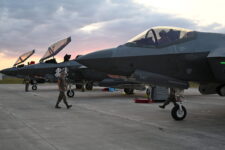
The US Capitol. (Photo by Anna Rose Layden/Getty Images)
It’s September, which means that it should be time for the annual Congressional rush to try and get the defense policy and funding bills through the House-Senate conference. But tragically, as Congress comes back into session, all the talk is actually about the length of the Continuing Resolution (CR).
Some want it to be as short as possible, lasting until just after the November elections. Some want it to last until March, so the new administration — and Congress — have a chance to make a mark on final spending for the year. Some say it should last through the entire next fiscal year, thereby just admitting defeat now and be done with it.
Sure, why not. Once you have completely shirked your duty and decided to just ignore the impacts, particularly on the nation’s competitiveness, security and military forces, why not just throw hands up in the air and work on other things?
Here’s the reality: Hope is not lost. There is actually still time left in this fiscal year to get both defense bills passed and put American security on track — if leaders on the Hill are willing to fight for it. As a reminder, providing for the common defense is the only mandatory and exclusive job of the federal government and, even though domestic discretionary spending may still go into a CR, the national security consequences of delayed defense funding are the most costly and dangerous for the nation.
First, let’s talk logistics. Only two of the four bills have gone through the entire pre-conference process, but that level of regular order is almost quaint these days. They could move quickly by taking the committee bills straight to conference; while that bypasses numerous elected representatives getting their chance to weigh in, they will still get a shot when the conference agreements come to the floors for a vote, which they actually must do before they can proceed to the president for signature.
This type of process is not ideal, but it is better than a government shutdown or a lengthy CR that only incrementally extends last year’s money and priorities into the new year and wastes time and money.
Despite the heated rhetoric of an election year, there are really only a half dozen big issues in play for the House-Senate conference to resolve to complete the bills on time: 1) the defense top line, 2) aircraft procurement, 3) equipment for the National Guard and Reserves, 4) military construction, 5) shipbuilding and 6) the pay raise for junior enlisted personnel. Once that first issue — the total amount of money the nation will invest in its security — is resolved, the others could quickly follow.
Concerning the topline, the below breakout of the budget by Service shows that the major difference is between the House and the Senate. The Senate appropriators provided $21.5 billion more than their House counterparts, a sum that would increase the competitiveness and readiness of our military.

Defense Toplines by Service Component
Next are a few major issues concerning funding levels to specific appropriations. First, within the aircraft procurement accounts, the various committees are about $3.5 billion apart, with the House Armed Services Committee as the outlier. With three of the four committees marking above $40 billion, we can expect a final agreed-upon bill to include an increase over the request in aircraft procurement
Next is equipment for the National Guard and Reserve Components. As usual, the administration requested no money for this account. However, Congress routinely provides about $1 billion in unrequested funds. Given appropriators in both chambers increased the account again this year, this should be easy to resolve in conference.
On military construction, the House kept close to the president’s budget while the Senate added numerous projects it designated as emergency spending. A resolution on this issue will be tied tightly to the defense topline agreement. If spending is close to the Senate level, then military construction is the clear winner. If not, these projects will not happen.
Next, and maybe the most consequential for the nation, is Navy shipbuilding. The House has marked at about $1 billion less than the Pentagon requested, a stinging rebuke in the confidence of the Navy to build ships. The Senate added several billion dollars, betting that the Navy, and the industrial base that supports it, can get its act together and produce the ships the nation needs. One can imagine that China is watching how this one will go.

Top Defense Conference Issues
The last major issue is the pay raise for junior enlisted military members. The Senate is taking a wait and see approach, with an additional one percent above the basic pay raise for these specific military ranks. They are waiting on the Secretary of Defense to release his Quadrennial Review of Military Compensation before taking action next year. The House is not waiting. Concerned with recruiting challenges and the effect of 20-plus percent of inflation over the past several years, they are recommending an additional 15 percent for the junior enlisted ranks. This could be resolved by simply splitting the difference with a 7.5 percent increase this year and the promise to review it again next year.
Though CRs have become shamefully routine, their damage remains. The artificial budget caps related to a forgotten debt ceiling fight in the midst of supporting Ukraine and Israel, along with the threat of an aggressive China, is sending a message of weakness to our autocratic adversaries and providing them with the willpower to fight on.
Yes, the deadline is close. But the issues simply are not that complicated. If Congress is willing to sit down and focus, rather than throw its hands in the air, America can be a more secure nation — not months down the line, but in a matter of weeks.
Elaine McCusker is a senior fellow at the American Enterprise Institute (AEI). She previously served as the Pentagon’s acting undersecretary of defense (comptroller). Retired US Army Maj. Gen. John G. Ferrari is a senior nonresident fellow at AEI. Ferrari previously served as a director of program analysis and evaluation for the service.





















